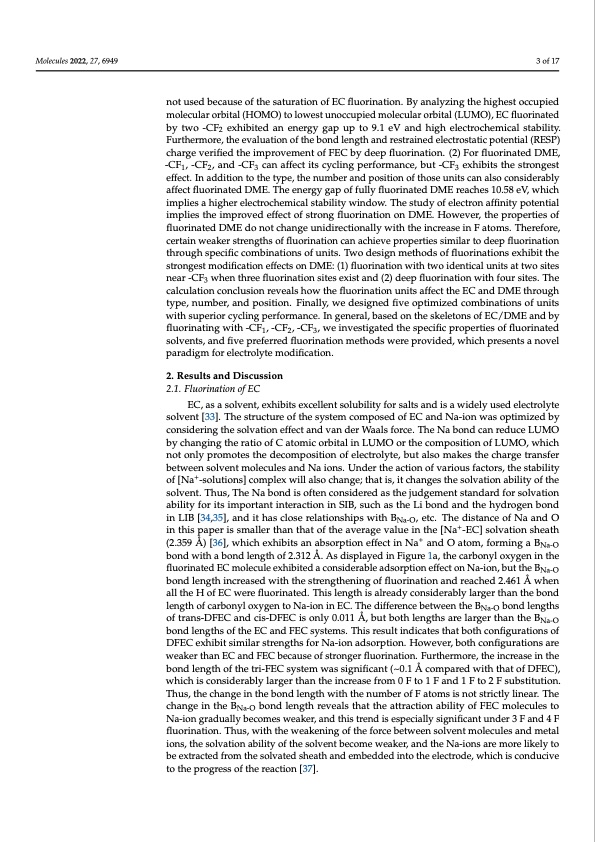
PDF Publication Title:
Text from PDF Page: 003
Molecules 2022, 27, 6949 3 of 17 not used because of the saturation of EC fluorination. By analyzing the highest occupied molecular orbital (HOMO) to lowest unoccupied molecular orbital (LUMO), EC fluorinated by two -CF2 exhibited an energy gap up to 9.1 eV and high electrochemical stability. Furthermore, the evaluation of the bond length and restrained electrostatic potential (RESP) charge verified the improvement of FEC by deep fluorination. (2) For fluorinated DME, -CF1, -CF2, and -CF3 can affect its cycling performance, but -CF3 exhibits the strongest effect. In addition to the type, the number and position of those units can also considerably affect fluorinated DME. The energy gap of fully fluorinated DME reaches 10.58 eV, which implies a higher electrochemical stability window. The study of electron affinity potential implies the improved effect of strong fluorination on DME. However, the properties of fluorinated DME do not change unidirectionally with the increase in F atoms. Therefore, certain weaker strengths of fluorination can achieve properties similar to deep fluorination through specific combinations of units. Two design methods of fluorinations exhibit the strongest modification effects on DME: (1) fluorination with two identical units at two sites near -CF3 when three fluorination sites exist and (2) deep fluorination with four sites. The calculation conclusion reveals how the fluorination units affect the EC and DME through type, number, and position. Finally, we designed five optimized combinations of units with superior cycling performance. In general, based on the skeletons of EC/DME and by fluorinating with -CF1, -CF2, -CF3, we investigated the specific properties of fluorinated solvents, and five preferred fluorination methods were provided, which presents a novel paradigm for electrolyte modification. 2. Results and Discussion 2.1. Fluorination of EC EC, as a solvent, exhibits excellent solubility for salts and is a widely used electrolyte solvent [33]. The structure of the system composed of EC and Na-ion was optimized by considering the solvation effect and van der Waals force. The Na bond can reduce LUMO by changing the ratio of C atomic orbital in LUMO or the composition of LUMO, which not only promotes the decomposition of electrolyte, but also makes the charge transfer between solvent molecules and Na ions. Under the action of various factors, the stability of [Na+-solutions] complex will also change; that is, it changes the solvation ability of the solvent. Thus, The Na bond is often considered as the judgement standard for solvation ability for its important interaction in SIB, such as the Li bond and the hydrogen bond in LIB [34,35], and it has close relationships with BNa-O, etc. The distance of Na and O in this paper is smaller than that of the average value in the [Na+-EC] solvation sheath (2.359 Å) [36], which exhibits an absorption effect in Na+ and O atom, forming a BNa-O bond with a bond length of 2.312 Å. As displayed in Figure 1a, the carbonyl oxygen in the fluorinated EC molecule exhibited a considerable adsorption effect on Na-ion, but the BNa-O bond length increased with the strengthening of fluorination and reached 2.461 Å when all the H of EC were fluorinated. This length is already considerably larger than the bond length of carbonyl oxygen to Na-ion in EC. The difference between the BNa-O bond lengths of trans-DFEC and cis-DFEC is only 0.011 Å, but both lengths are larger than the BNa-O bond lengths of the EC and FEC systems. This result indicates that both configurations of DFEC exhibit similar strengths for Na-ion adsorption. However, both configurations are weaker than EC and FEC because of stronger fluorination. Furthermore, the increase in the bond length of the tri-FEC system was significant (~0.1 Å compared with that of DFEC), which is considerably larger than the increase from 0 F to 1 F and 1 F to 2 F substitution. Thus, the change in the bond length with the number of F atoms is not strictly linear. The change in the BNa-O bond length reveals that the attraction ability of FEC molecules to Na-ion gradually becomes weaker, and this trend is especially significant under 3 F and 4 F fluorination. Thus, with the weakening of the force between solvent molecules and metal ions, the solvation ability of the solvent become weaker, and the Na-ions are more likely to be extracted from the solvated sheath and embedded into the electrode, which is conducive to the progress of the reaction [37].PDF Image | First-Principles-Based Optimized Design of Fluoride Electrolytes

PDF Search Title:
First-Principles-Based Optimized Design of Fluoride ElectrolytesOriginal File Name Searched:
molecules-27-06949.pdfDIY PDF Search: Google It | Yahoo | Bing
Salgenx Redox Flow Battery Technology: Salt water flow battery technology with low cost and great energy density that can be used for power storage and thermal storage. Let us de-risk your production using our license. Our aqueous flow battery is less cost than Tesla Megapack and available faster. Redox flow battery. No membrane needed like with Vanadium, or Bromine. Salgenx flow battery
| CONTACT TEL: 608-238-6001 Email: greg@salgenx.com | RSS | AMP |